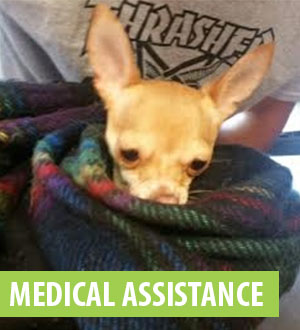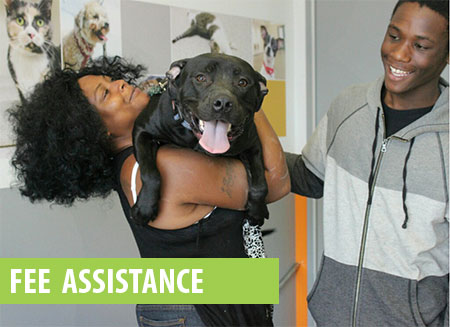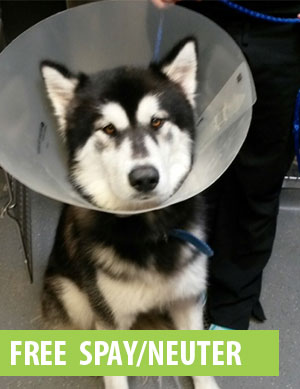 One of the most common questions I’ve been asked for almost twenty years now is: If a person can’t take care of themselves and their family, why should they have a pet?
One of the most common questions I’ve been asked for almost twenty years now is: If a person can’t take care of themselves and their family, why should they have a pet?
When I began working with homeless dog owners living on Skid Row back in 1996, this wasn’t a question I ever considered because it wasn’t any of my business. I have always believed, and still do believe, that everyone deserves support. Meeting someone where they are in life today, in whatever situation they’re in, along with their pet, and offering them options, resources, and solutions is vital in order to truly make lasting change for animals.
It’s highly likely that if you’re reading this blog, you care deeply about animals. We’re so glad that you do. But what about their people? Because many of these people are extremely poor; it can feel to them as if they’ll never get out from under it. Some live on the street, or in their cars, or they rely on motel vouchers to get by. And these same people often sneak their pets into those motels when no one is looking, or hide them on the bus, or make the street-life or car-living work for as long as possible until they are forced to give up their pet. Yes, forced. Because the truth is, some of the families we serve make an income of less than $1,000 a month. Sometimes it’s far less than that. Whether low income or no income, the working poor, or under employed, however it’s defined, this population has one thing in common when it comes to their animals: if a single minor emergency happens, there is little if anything that the pet owner can do.
 For example, this little dog (pictured left) was almost surrendered to the South LA Shelter for having seizures. The family paid for an exam and were told by the veterinarian that his condition could be very expensive, including daily medicine and more testing. Despite not wanting to surrender “their baby,” the family felt they had no choice. They could not afford the treatments and procedures. That’s where our shelter intervention program stepped in and offered financial assistance in order to help keep one more little brown Chihuahua from coming into the shelter. Because this dog had a home and a loving family who wanted him. Should they be deemed unworthy of having a pet simply because they couldn’t afford his extreme health condition? We don’t think that’s fair. We believe in opening our hearts to animals, and the people who love them.
For example, this little dog (pictured left) was almost surrendered to the South LA Shelter for having seizures. The family paid for an exam and were told by the veterinarian that his condition could be very expensive, including daily medicine and more testing. Despite not wanting to surrender “their baby,” the family felt they had no choice. They could not afford the treatments and procedures. That’s where our shelter intervention program stepped in and offered financial assistance in order to help keep one more little brown Chihuahua from coming into the shelter. Because this dog had a home and a loving family who wanted him. Should they be deemed unworthy of having a pet simply because they couldn’t afford his extreme health condition? We don’t think that’s fair. We believe in opening our hearts to animals, and the people who love them.
 Furthermore, we know that the only thing constant is change. The family mentioned above who is living in poverty with their dog may work their way up and out of their current financial situation. They may be able to one day support themselves without assistance, and it could happen in a matter of months or a couple years. We hope it does. But the life expectancy of a Chihuahua is 15-18 years. Therefore, in theory, any dog in any family has the potential to spend a fraction of his life in poverty with his family. The key here is WITH HIS FAMILY.
Furthermore, we know that the only thing constant is change. The family mentioned above who is living in poverty with their dog may work their way up and out of their current financial situation. They may be able to one day support themselves without assistance, and it could happen in a matter of months or a couple years. We hope it does. But the life expectancy of a Chihuahua is 15-18 years. Therefore, in theory, any dog in any family has the potential to spend a fraction of his life in poverty with his family. The key here is WITH HIS FAMILY.
A better question to ask might be: How can we keep more pets in their first home, making it a forever home?
One of the answers is by helping pet owners financially when they cannot afford it. We’ve paid for licenses and redemption fees to help get pets out of the shelter, and we’ve watched these animals walk out the door, headed back home. The alternative, without our intervention, could have been the unnecessary euthanasia of a loved pet.

Another important goal we have revolves around making all spay/neuter free, even if the pet owner can’t produce documents to “prove” how poor they are. This is another way we support pet retention in the long term, as we believe anybody claiming to need a helping hand should be entitled to it. Their animals certainly should.
Yet another method of assistance is offering to pay for short term boarding or providing a foster home for pets that belong to people who are in transition. We’ve seen it time and time again — someone is moving and cannot take their pet immediately. It only they had a place to keep their dog or cat safe for a week or two, this pet could be avoid coming into the shelter. Think about how many more animals would never need rescuing if they were able to stay with their people.

Lastly, sometimes it’s just a free bag of food every month that stops an animal from entering the shelter. Unfortunately many families run out of money by the end of a month to buy food for themselves, not to mention their pets. This doesn’t mean they don’t care about their family; it means they need a little help to get by so that their dog or cat won’t suffer in hunger. Without generous food programs, a person who loves their pets may feel that if they can’t feed them every day easily, then the shelter is the only alternative.
These are some of the many ways we can help people and animals at the same time. In our experience, they’re not separate issues. Close your eyes for a minute and imagine a day when we can prevent every pet who has a caring family from entering a shelter. We guarantee you, when this day comes we’ll realize that we don’t have a pet overpopulation problem; we have a poverty problem. These people, who are often vilified for leaving their pets at the shelter, are worthy of our assistance. They are struggling socioeconomically, but so many of them love their pets and want what we want — to keep them in their home.
 We believe there are indeed enough happy homes out there, if only every person who wants to keep their pets can do so. Plus, if everyone who loses a pet and finds him or her at the shelter is able to pay the fees to be reunited, less animals will languish in kennels. Combine this with a robust free spay/neuter campaign (like we have in South Los Angeles) and we will see a reduction in the killing of healthy, adoptable animals across the board.
We believe there are indeed enough happy homes out there, if only every person who wants to keep their pets can do so. Plus, if everyone who loses a pet and finds him or her at the shelter is able to pay the fees to be reunited, less animals will languish in kennels. Combine this with a robust free spay/neuter campaign (like we have in South Los Angeles) and we will see a reduction in the killing of healthy, adoptable animals across the board.
Perhaps we’ve struggled to find the solution to shelter killing for so long because we haven’t been asking the right questions. Consider letting go of the need to wonder if these people should have a pet, and instead ask: How can I be a part of keeping animals in loving homes?
The answer now seems so clear.
If you want to help us make this happen, if you want to be a part of this work — addressing the core issue — please consider becoming a monthly supporter of Downtown Dog Rescue’s Shelter Intervention Programs, which are currently operating in South LA, East Valley, and North Central locations of Los Angeles City animal shelters.




